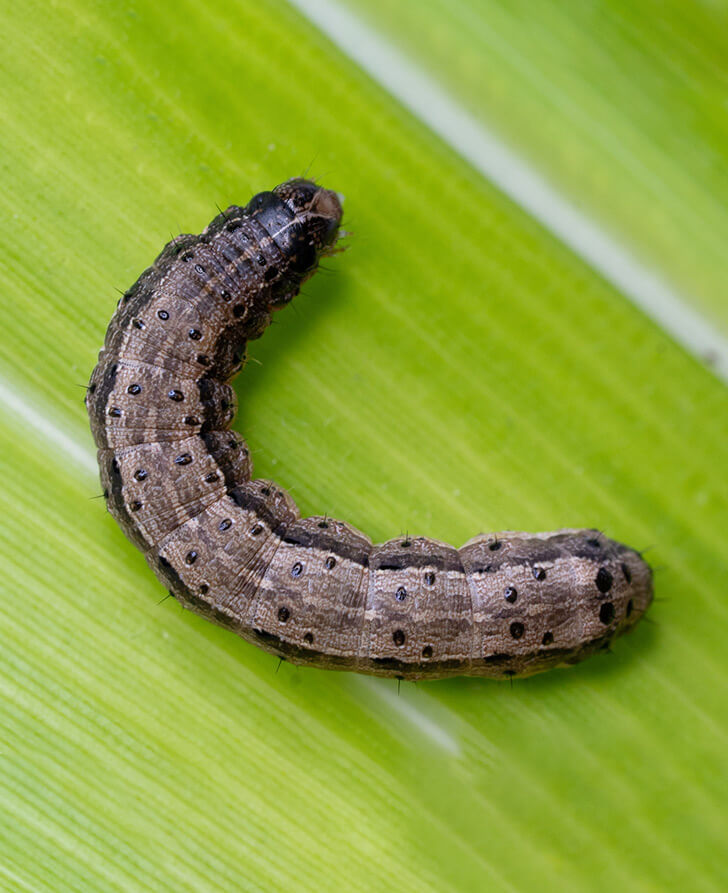Armyworm Overview
The Armyworm is one of the most common pests in North America. Its name is derived from the way they travel across places in an army-like manner. Armyworms consume anything on their track. There are several species of Armyworm; many of them have a particular host plant while others feed on anything green. Armyworm's primary source of food is grasses like oat, wheat and corn but they can also be a problem to vegetable crops such as cabbage, cauliflower, cucumber, beets, beans, radishes, sweet potatoes, carrots, peas, lettuce and onion.
GET A QUOTE NOWIdentification
Armyworm larvae vary in color from green to tan brown to black. There are long light orange, white and brown stripes that flow below their head capsule to the end on each side of their body. This smooth-skinned larva has a series of brown veins that give them a blotchy look.
Armyworms at the pupal stage remain in the brown shell just beneath the surface of the soil. The armyworm moth approximately measures 1 inch long with a 1 ½ inch wing size and light brown in color. This pest changes its color as they develop and mature.
Main Service Areas For Armyworm Removal
-
 Boca Raton Armyworm Control
Boca Raton Armyworm Control
-
 Boynton Beach Armyworm Control
Boynton Beach Armyworm Control
-
 Lake Park Armyworm Control
Lake Park Armyworm Control
-
 Lake Worth Armyworm Control
Lake Worth Armyworm Control
-
 Palm Beach Gardens Armyworm Control
Palm Beach Gardens Armyworm Control
-
 Palm Beach Armyworm Control
Palm Beach Armyworm Control
-
 Palm Springs Armyworm Control
Palm Springs Armyworm Control
-
 Riviera Beach Armyworm Control
Riviera Beach Armyworm Control
-
 South Bay Armyworm Control
South Bay Armyworm Control
-
 South Palm Beach Armyworm Control
South Palm Beach Armyworm Control
-
 West Palm Beach Armyworm Control
West Palm Beach Armyworm Control
-
 West Lake Armyworm Control
West Lake Armyworm Control
-
 Coral Springs Armyworm Control
Coral Springs Armyworm Control
-
 Fort Lauderdale Armyworm Control
Fort Lauderdale Armyworm Control
-
 Pompano Beach Armyworm Control
Pompano Beach Armyworm Control
-
 Coconut Creek Armyworm Control
Coconut Creek Armyworm Control

Life Cycle
The life cycle of armyworms begins when a group of eggs is laid by the adult female on the base of plants or leaves of grasses. After 5-10 days, tiny caterpillars hatch and feed for many weeks. These larvae are light green with looping movements. Armyworm larvae are very active at night feeding on their host plants while you can find them during the day below the plant debris. They will pupate and after completing 6 instars within 1-2 weeks, the adult armyworms emerge. More than three generations occur every season.
Damage
Armyworm infestations usually start in areas where grass grows. Larvae are also fond of feeding on small grains, corn and vegetable crops causing extensive damage. They consume leaf tissue and chew the leaves of the host plant until they look like skeletons. Armyworms can strip the leaf margins and move to the next host plant to continue feeding.
Control
If pest numbers are low using predators like birds can help in controlling the number of armyworms. However, if this is an outbreak, using pesticides that can kill them is the best option. Another simple way to control this pest is by keeping the turf neatly trimmed can also help in reducing their numbers. Hand-picking them and dropping them to a bucket of soapy water can also be effective.
GET A QUOTE NOWLicensed, Trusted Pest Control Services
At Fleming Lawn and Pest Services, we protect your home or business with superior care. Unlike the “Big Pest Control companies” we don’t pay our technicians based on how many locations they treat in a day.